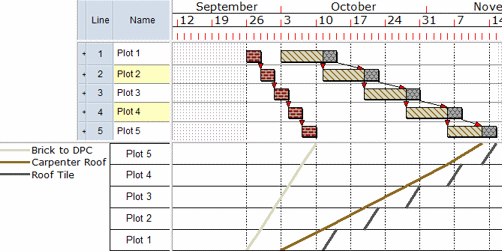Adjusting the work face frequency of gangs, trades or stages
You can adjust the work face frequency, or rate of production, of the gangs, trades or stages that are working on activities in a Line of Balance graph. You may want to do this if a Line of Balance graph shows that a stage is working discontinuously or that there are conflicts between different stages that need to be resolved.
You adjust the work face frequency of a stage by specifying the number of gangs, trades or stages that will be working in parallel on the tasks to which that stage is assigned; the higher the number you enter, the greater the rate of production. The new work face frequency applies to the tasks that relate to the selected segment of the Line of Balance graph, and to all uncompleted tasks that relate to the same stage either to the right or to the left of the selected segment - you can specify which. When you change the work face frequency of a stage, the affected tasks are rearranged in parallel groups of the given number of work faces accordingly.
For example, if a particular stage relates to teams of carpenters and you change the work face frequency of the stage from 1 to 2 going forward from the selected segment, you are indicating that two teams of carpenters will work in parallel from that point onwards. Tasks that relate to the same stage - ie tasks on which carpenters will work - are therefore rearranged in parallel groups of 2 from the selected segment onwards, to reflect the fact that two tasks can be worked on at the same time, each one by a different team of carpenters. Conversely, if you reduce the work face frequency from 2 to 1, tasks are rearranged to reflect the fact that only one task can be worked on at a time.
In the project illustrated below, the second stage - the one relating to the middle line in the Line of Balance graph - is 'Carpenter Roof'. At the moment, all of the stages in the graph have a work face frequency of 1, which means that each stage can only work in one location at a time without causing conflicts:

If you were to right-click the line representing the 'Carpenter Roof' stage in the 'Plot 2' row of the graph - the row relating to the second location - and select Work Face Frequency, then set the number of work faces to 2 from this point forwards, the result would be as follows:

The graph now shows that from the second location onwards, the 'Carpenter Roof' stage can work in two locations at the same time: the 'Carpenter Roof' tasks are doubled up from Plot 2 onwards. Note how changing the work face frequency of the 'Carpenter Roof' stage has also resulted in the production rate of the third stage - 'Roof Tile' - being improved, even though the work face frequency of this stage has not been changed. Note also that Holding Pin constraint flags have been applied to the 'Carpenter Roof' tasks to ensure that rescheduling the project will not move the tasks to an earlier date.
To adjust the work face frequency of a gang, trade or stage:
- Right-click a segment of a Line of Balance graph that corresponds to the stage that you want to edit and select Work Face Frequency. The Work Face Frequency dialog appears.
- Enter the number of gangs, trades or stages that will be working together on tasks in the Line of Balance graph at the same time in the Number of work faces field.
- Click the appropriate From this point radio button to specify whether tasks to the right or to the left of the selected segment that relate to the same stage should be rearranged in parallel groups of the given number of work faces, to reflect the revised number of gangs, trades or stages that will be working in parallel.
Note that if you choose to rearrange the tasks to the left of the selected segment by clicking Backward, only tasks that can be rearranged without affecting the position of tasks relating to other stages are moved. - Select the Reschedule after move check box to specify that the project should be rescheduled automatically once the tasks that are affected by the change in work face frequency have been rearranged, or clear the check box to specify that the project should not be rescheduled automatically.
- Click OK.
Reapplying work face frequency adjustments following changes to the project
Changes that are made to the position of tasks as a result of adjustments to the work face frequency of a gang, trade or stage in a Line of Balance graph can be lost following changes elsewhere in the project. For example, if you reschedule the project subsequently, the reschedule does not take account of changes that have been made to the position of tasks as a result of adjusting work face frequency. This means that following changes to a project, your Line of Balance graph may not appear as you wish.
If this happens, you can reapply all of the work face frequency adjustments that you have made to a Line of Balance graph, in order to rearrange the tasks that are included in the graph according to the work face frequency adjustments that you have made. To do this, right-click a blank area of the Line of Balance graph and select Re-apply all WFF.
Moving tasks by clicking and dragging in a Line of Balance graph
Viewing details of the tasks graphed in a Line of Balance graph